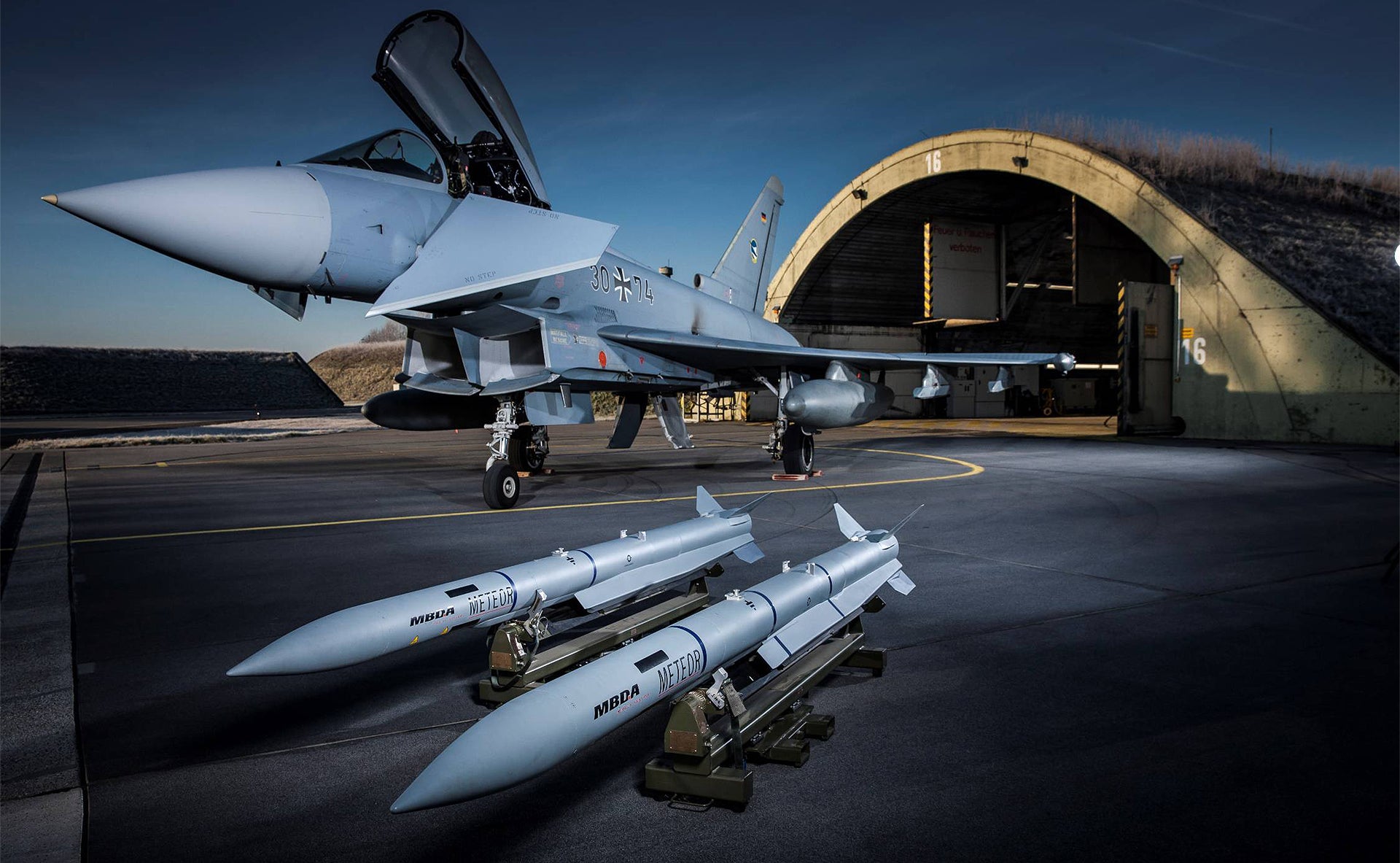For years now there has been a ton of hype about MBDA’s Meteor beyond-visual-range air-to-air missile, but now that it has reached operational status, blanket claims are being tossed around in the media as to its capabilities: headlines like “the best in the world“ and “the most deadly” are commonplace. But is it really that simple? Is the Meteor the dream missile every western fighter needs under its wings or in its weapons bays or is it a niche capability?
Rising Meteor
The truth is that the Meteor isn’t that new at all as it has been in development for nearly two decades. Still there is no doubt that the missile is extremely impressive, but it is not necessarily the best solution for the beyond-visual-range (BVR) job for all fighters and for all scenarios.
The Meteor’s roots can be traced back to the mid-1990st grew out of a common European need for a next generation BVR missile. This new missile had to have superior range and overall kinematic performance than the American AIM-120 AMRAAM. The UK, France, Sweden, Germany, Italy and Spain all participated in the program and although European aerospace and defense consortiums are nothing new, some aspects of what the Meteor brings to the fight is.
Meteor’s most impressive feature is its propulsion concept. Think of the Meteor more as an air-to-air cruise missile than as a traditional guided air-to-air rocket. For propulsion, it uses a solid fuel, variable flow, ducted rocket—also referred to as a ramjet—instead of a traditional rocket motor. What this means is that Meteor can throttle its engine during different phases of flight whereas a rocket delivers all of its potential energy in one continuous unmodulated burn cycle. This capability may not sound like a huge deal, but it is.
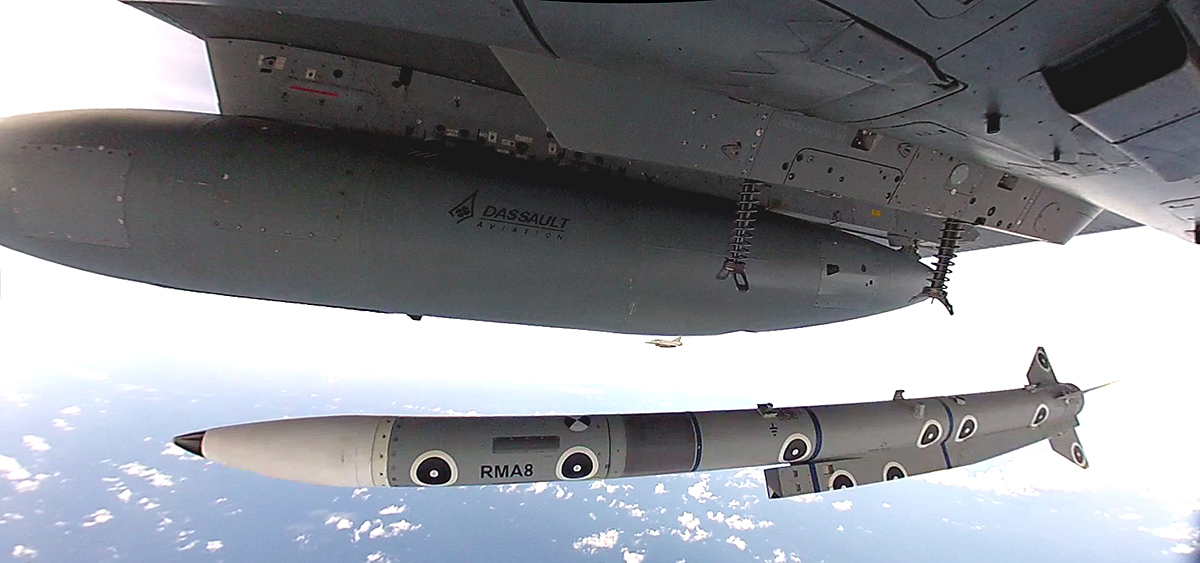
Nowhere to run to
When a standard air-to-air missile is fired at a target it delivers the same amount of thrust over a certain period regardless of the tactical scenario. If the target can be reached without the rocket motor burning out, or shortly after it does so, the missile will have a high-energy state during its terminal attack phase. This will allow it to maneuver very hard, easily countering a target aircraft trying to evade the incoming missile. If the target is farther away, the missile will usually climb to a high altitude while its rocket motor is burning and then coast on its built-up energy with gravity on its side until it reaches the terminal phase of its flight (its final attack run).
If the target isn’t too far away, and the missile is still above it, it will dive down on the target in an attempt to maximize its ability to make hard maneuvers. The longer the shot, the less energy the missile will have for its critical terminal phase of flight, and that is not a good thing.
Enter the ramjet powered Meteor. Instead of burning off all its fuel right after launch it can throttle its engine back during cruise, thus saving fuel. As it approaches its target it can throttle up, eventually making its terminal attack while at its highest possible energy state, around mach 4.5, even when fired over long ranges.
Not only does this mean the Meteor will have more energy to maneuver during the endgame of the engagement, but this capability also drastically increases the size of the missile’s “no escape zone.” Basically, the Meteor has a far greater ability to “chase” and catch enemy aircraft over long ranges.

So more than just being a better beyond-visual-range (BVR) missile via high-end sensors and a larger rocket motor, Meteor has a totally different—and much smarter—propulsion concept, that not only increases range but also increases its effectiveness of the missile over that range.
A missile that listens and talks to its master
The Meteor competes in other ways than just propulsion. It packs an active X-band radar seeker for locking onto targets during the terminal phase of its flight. In fighter pilot parlance this is when the missile goes “pitbull” and becomes a true fire-and-forget weapon. In other words, the firing aircraft does not need to guide it any farther toward its target in order to ensure that it gets a lock and can make its final attack on its own.

There is a common misconception about most modern BVR missiles, especially the AIM-120 AMRAAM. It is regarded as a fire-and-forget weapon, and it does have a mode to do just that. Basically it takes the targeting data from the aircraft’s radar and calculates where the target “should be” when it arrives in the target area.
It then flies out to that area using its own inertial navigation system. Once there, the missile’s small radar seeker, which has far less range and scanning capability than the radar on the fighter that fired it, starts to look for the bad guy. If said bad guy is within the AMRAAM radar’s cone of detection it can lock on and attack.
The problem is that at intermediate and medium ranges, fire-and-forget performance is abysmal. If the target is not where the missile thought it would be, within a limited cone of the sky, it’s a miss. As such, this mode is more effective for defensive shots as anything else or for shots taken at close ranges where there is less flight time in which the enemy can change course, altitude and tactics.
The way the AIM-120 missile is usually employed at range is by the fighter aircraft that launched it sending it mid-course updates as it flies out to the target. As it goes along its way, and as the range between the missile and the target decreases, its ability to predict where the target will be improves as it has much more recent telemetry to rely on. Ideally the fighter will provide updates to the missile until it locks its own radar on the enemy target.
There is a tradeoff between risk and reward for the pilot firing the missile. He can keep his radar pointing towards the bad guy and continue sending radar data to the missile to improve its chances of a kill, but that may expose him to the enemy as range between him and the target decreases. Once the missile goes “pitbull” and has locked its own radar on the target at close range the pilot can perform the “forget” part of fire and forget concept and can break its lock.
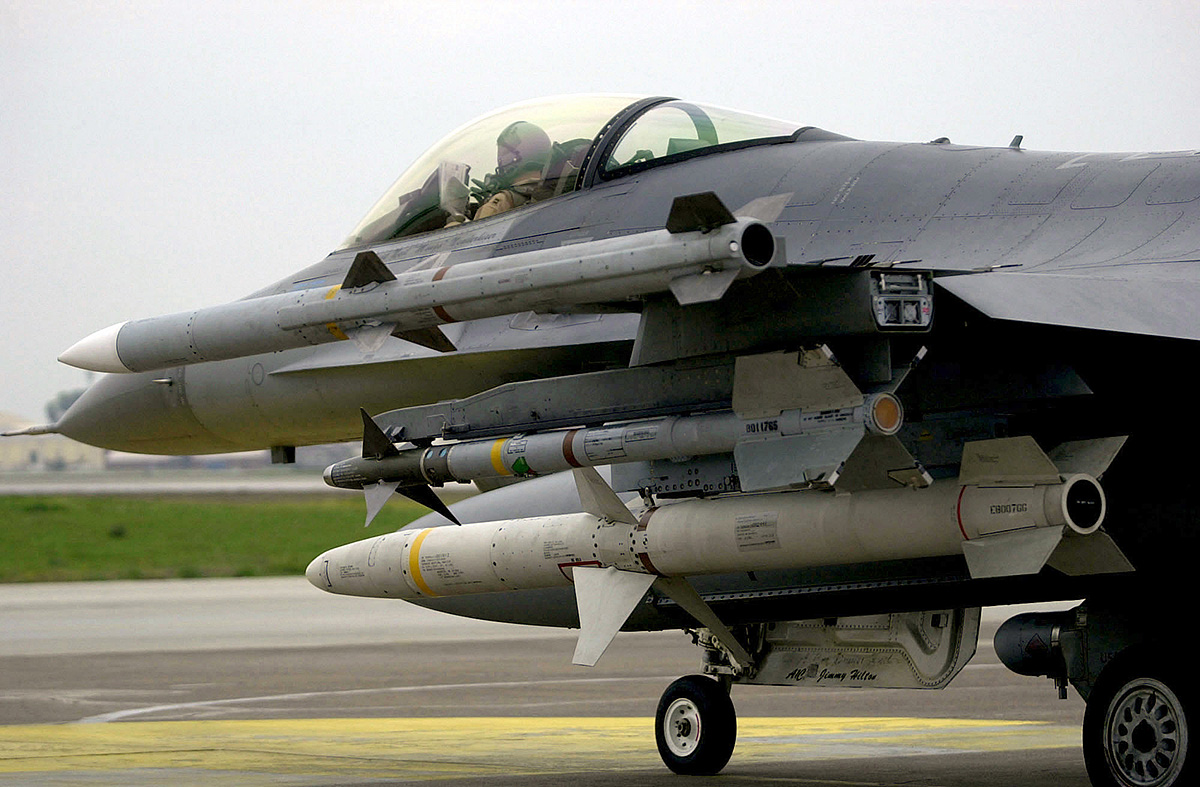
Like the AIM-120, the Meteor probably has a fire-and-forget mode, but mid-course updates are not only key to the missile’s success. Because the missile can modulate its throttle, the autopilot can provide the most efficient flight profile to the target in long-range shots. Greater range means less certainty of where the target will be by the time the missile is close enough to detect it itself.
The Meteor will be able to get those crucial mid-course guidance updates not just from the jet that fired it, but from “third party” sources as well. These can include other fighters, airborne early warning and control (AEW&C) aircraft, and land and sea-based radar and electronic surveillance systems that provide their own “sensor pictures” to the missile-firing aircraft via data-link. With many assets contributing to a common tactical network “picture” via common data-link waveform and language it provides information that anyone, including the Meteor-armed fighter and the Meteor itself, can exploit.
In fact, the launching jet’s pilot may never have to use his own radar at all to engage a target. Instead he simply assigns the missile a target on his situational display. The missile then gets continuous updates from third party sources—rather than the fighter that fired it—right up to its final attack sequence.
Even if the data-link does not provide high-fidelity “target tracks” that does not mean they are not engagement quality as the missile only has to have the target within its own radar’s cone of detection in order to initiate the terminal attack phase of its flight. This means getting the Meteor close to the target is good enough.
The Meteor’s data-link also has two-way capability, so the pilot could re-target the missile while it is already on its way. The pilot can also see the missile’s fuel, energy and tracking state in real-time. This is essential for making quick decisions as to whether or not to fire another missile at the target or to run away if it is properly tracking toward the target or has obtained its own lock.
The thing is that modern data-links on missiles are not exclusive to Meteor, or to modern air-to-air missiles for that matter, but let’s keep it to that scope for this piece.
Reaching peak AMRAAM
Enter the AIM-120D Advanced Medium Range Air-to-Air Missiles (AMRAAM), the latest incarnation of the 25 year old Raytheon-built AMRAAM which has even been adapted for surface-to-air use. The D model, which is just coming online right now, also has a two-way data-link with third party targeting capabilities like the Meteor. Additionally, it sports 50% more range than the previous version of the ARMAAM, the AIM-120C7, which itself had increased range over its predecessor variant the AIM-120C5.
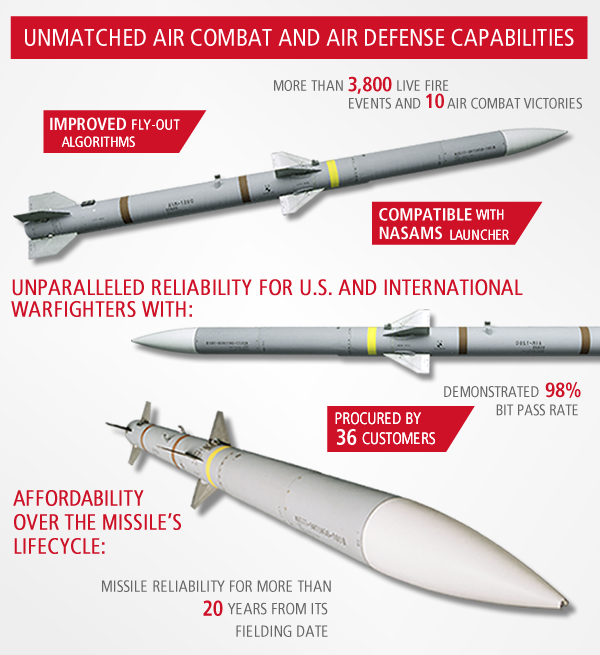
Other improvements found in the AIM-120D include an enhanced seeker with a better ability to detect targets off-boresight (off the missile’s centerline axis). This is a big deal for the critical terminal phase of flight, since it can scan a larger area while trying to acquire the target on its own. This upgrade also makes it harder for the enemy to shake the missile of its trail.
The AIM-120D’s capability to engage targets at short range will also be enhanced by this feature, which is a boon for the F-35, which does not carry a short-range air-to-air missile while in stealth configuration. The EA-18G Growler, which is also limited to the AIM-120 alone, will also gain uniquely from this improvement.
This new AMRAAM will also feature a better navigation system with its inertial navigation system (INS) augmented with embedded GPS. Also like the Meteor, the AIM-120D has the latest electronic-countermeasure-countermeasures, making it very hard for the enemy to jam or confuse it.
Overall, these improvements elevate what has already been the “gold standard” of BVR air-to-air missiles for decades. What this new AMRAAM doesn’t have is the Meteor’s ramjet engine and all the benefits that go along with it.
More range over the current AIM-120 is in many ways needed to match the great leaps in fighter radar technology and networked warfare that have become a reality in the last decade and a half. Active Electronically Scanned Array radar sets can see much farther and in much higher fidelity than their mechanically scanned predecessors. This has left pilots who fly fighters equipped with them in a strange predicament where they can see the enemy from much farther away than their missiles are capable of engaging.
The F-15C’s APG-63V3 AESA can reach out much farther (on an order of multiples depending on the target and scenario) than the radar it is replacing. Being able to see bad guys at well over 100 miles away, but only being able to kill that bad guy at say 40 miles is an issue for the very unstealthy Eagle, but not so much for a low-observable fighter. In fact, the F-22 Raptor (and the F-35 eventually) really don’t need larger, longer-ranged missiles, they need more missiles.
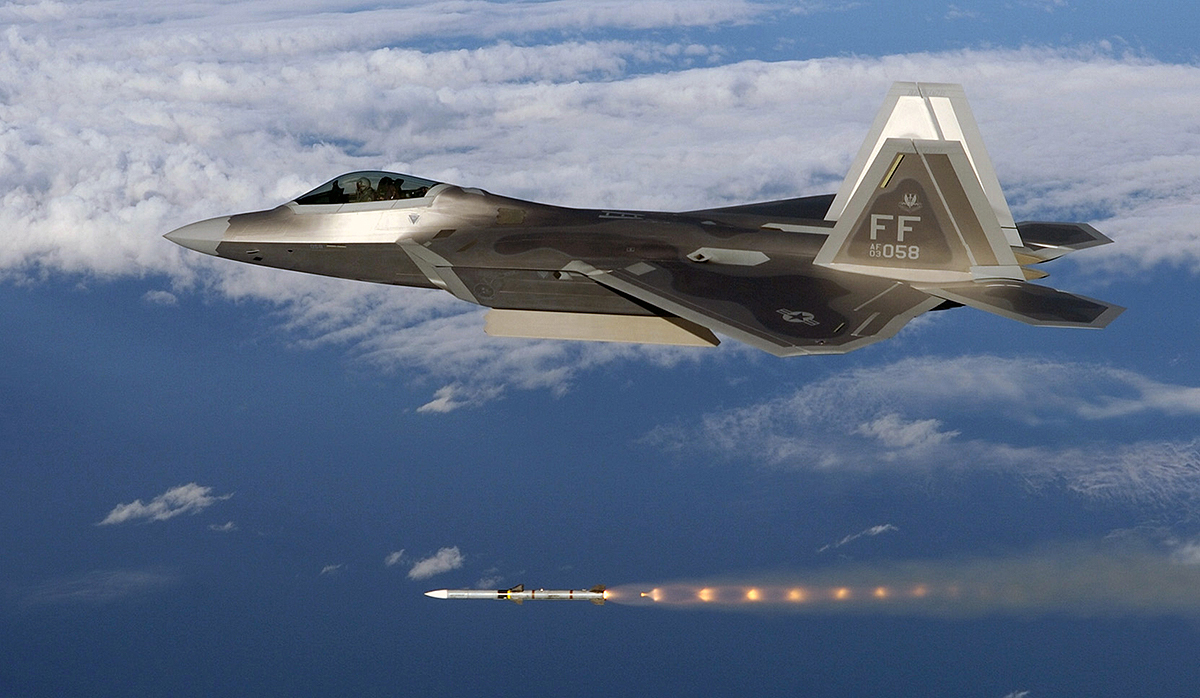
More missiles, please
If you ask a F-22 pilot what they want more than anything else, you are very likely to hear “more missiles.” The aircraft, with its stealthiness, supercruise capability and superior situational awareness can get far closer to the bad guys without detection than their 4th generation counterparts like the F-15C. The problem is that the F-22 only has six AIM-120 AMRAAMs at its disposal, and the F-35 will only have four.
Finally, adding the AIM-9X to the F-22’s quiver will actually help with this deficiency as the missile has a limited intermediate range capability, but employing it against certain targets may be too close to comfort. A solution for this conundrum is quietly in the works in the form of a smaller BVR missile like Lockheed’s conceptual Cuda air-to-air missile, also nicknamed the “Halfaraam.” This thing is like the Small Diameter Bomb of air-to-air weapons and will theoretically increase the F-22’s beyond-visual-range missile load by at least double. The F-35 will also greatly benefit from it or a weapon like it.
Parallel initiatives to develop such a weapon have been recently dubbed by the USAF the Small Advanced Capability Missile (SACM) and Miniature Self-Defense Munition (MSDM). These are two separate research and development programs that have been awarded to Raytheon and seem to have similar goals. Lockheed’s Cuda could also evolve into a competitor for such a requirement if it were to formally move outside of the exploratory phase or even as a self-funded weapon option.
Although details still remain sketchy, the Cuda’s compact size comes at the sacrifice of two things. The first is the deletion of a warhead. Instead of a 30lb-50lb shrapnel-encased charge and proximity fuse system like what most air-to-air missiles use, the Cuda will slam into its victims like a bullet. This hit-to-kill capability, which has evolved greatly in recent years via ballistic missile defense research, should cause more than enough trauma to fighters to take them down and would probably result in at least a mission kill against larger airframes.

The Cuda will also sacrifice range in comparison to its more long and slender BVR missile cousins. Instead of being able to engage targets at 50 miles (or in the AIM-120D’s case likely much farther), it should be able to do so at ranges of half that distance depending on the scenario. Using such a weapon offensively may be somewhat suicidal for 4th generation fighter, but for 5th generation jets it’s a day’s work.
Cuda, or a missile like it, will also likely feature extreme agility as it has to impact its target directly, not detonate its warhead nearby. This will also make it a capable short-range dogfight missile. This means aircraft like the F-35, that lack a short-range air-to-air missile during stealthy operations, would now have a good option for closer-range situations.
In many ways such a weapon will complement the AMRAAM, or even the Meteor, wonderfully. Instead of carrying a pair of AMRAAMs and a full air-to-ground internal load, an F-35 could carry an AMRAAM and two Cudas. This gives F-35 pilots more options and a greater ability to defend themselves as they make their way in and out of the target area.
These missiles would also likely be able to have the ability to engage surface and ground targets as well, like the AIM-9X, but at much greater ranges. For stealth aircraft, these smaller intermediate-range air-to-air missiles could be a viable weapon for suppression of enemy air defenses if adapted to that mission.
With all this in mind, when it comes to the Meteor and the F-22 and F-35, there simply is far less of a need for its extreme range, and its more bulky structure would just take up more precious real estate within the jets’ weapons bays than the AIM-120 currently does.
America’s air arms and the Meteor
So where does the Meteor and potential future missiles like it fit in with America’s air arms? The US will operate a 4th generation fighter fleet for many decades to come, including F-15s, F-16s and F/A-18 Super Hornets. At face value the Meteor may seem like a relevant weapon for these aircraft to have in high-threat, peer-state warfare scenarios, especially if they are upgraded with AESA radar sets and the latest data-link modems, but even this is on a case-by-case basis
Let’s take the US Navy for instance. With a resurgent threat from major peer-state competitors like Russia and China, the Meteor is the missile to have. It would match well with the Navy’s Super Hornet fleet which is almost entirely equipped with APG-79 AESA radars. It would also finally replace the AIM-54 Phoenix long-range air-to-air missile that was retired with the F-14 Tomcat. Basically it would bring back a real “fleet defender” capability to the Navy’s Carrier Air Wings, and the Super Hornet could carry a lot of Meteor’s at one time if need be and bring them back to the ship. This is something the Tomcat could not do with the Phoenix.

The F-15C could use the Meteor as a longer-range alternative to the AIM-120D but fitment may be an issue. Carrying four on the F-15C’s belly stations should be possible, but the feasibility of mounting them under the Eagle’s wings above drop tanks is questionable. Still, the idea of an F-15C with a pair of AIM-9Xs, a pair of AIM-120Ds, and four Meteors is very enticing as it would make the best of the F-15C’s massive AESA radar. But really the jet could get by with AIM-120D just fine for its mission, which largely includes domestic air defense tasking, and in a major conflict it would not fight alone. And this is precisely where the Meteor’s value comes into play vis-à-vis the F-15C and the F-22, but that will have to wait for a moment.
As much as beyond-visual-range combat is hyped these days, and technology is certainly caught up with the concept, the operational realities that most 4th generation fighters will find themselves in the future doesn’t really support the idea that dog-fighting is dead. Rules of engagement and fear of friendly fire incidents make very long-range missile shots unpalattable during coalition operations like those we have seen time and time again against non-peer state foes over the last few decades.
The cold hard reality is that visual identification of the target is still where the bar sits for weapons release during many operations. Using targeting pods slaved to a 4th generation fighter’s radar (like the F-15C has today via the Sniper pod), or using the F-35’s Electro-Optical Targeting System (EOTS) for long-range examination of aerial targets, can help greatly with this hurdle. The only issue is that using these systems for visual identification of a potential enemy still puts such an engagement deep within the range of any AIM-120 variant. As such, the benefits the Meteor offers would are nullified.
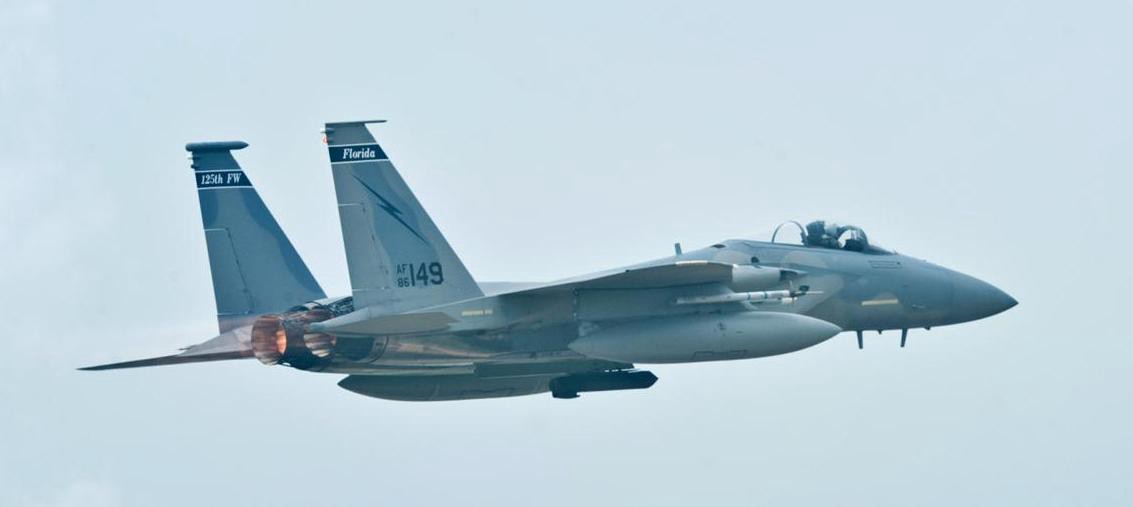
In other words, if you look at history, for the vast majority of operations the Meteor’s extreme range will be unnecessary. That does not make it irrelevant, far from it, but it all depends on what fighters an air arm has at its disposal. For instance, a country that is not buying the F-35 should invest in Meteor to get the best standoff range for their advanced 4th generation fighters. This is especially so if they feel like their fighter aircraft would be used outside of coalition operations with the US at the helm. A Super Hornet equipped Royal Canadian Air Forcefor instance that has to protect its great norther expanse could really use the Meteor.
Meteor and the USAF’s F-22A/F-15C air dominance team
Remember how we just discussed that the F-22 and the F-35 could use more missiles, lots more, especially to counter-balance against a capable home-team foe with a quantitative advantage? Well when we step outside the platform “vacuum” and look at the F-22 and F-15 as a team, you can see how the Meteor could be a huge force multiplier.
F-15C and F-22 battle doctrine is still taking shape, with small but critical initiatives underway to drastically improve their interoperability. Case in point the podded Talon Hate system which you can and should read all about in one of my past features linked here.
This big fuel-tank shaped pod hangs underneath an F-15C and works as a mobile information gateway data fusion center. It takes information shared among F-22s via their own proprietary and stealthy data-link, including sensor info and communications, and translates it, fuses it, and re-broadcasts it in a data-link waveform and language that F-15s can understand and display to their pilots. Most likely it also is capable of piping this information out to any Link 16 data-link user in the area.
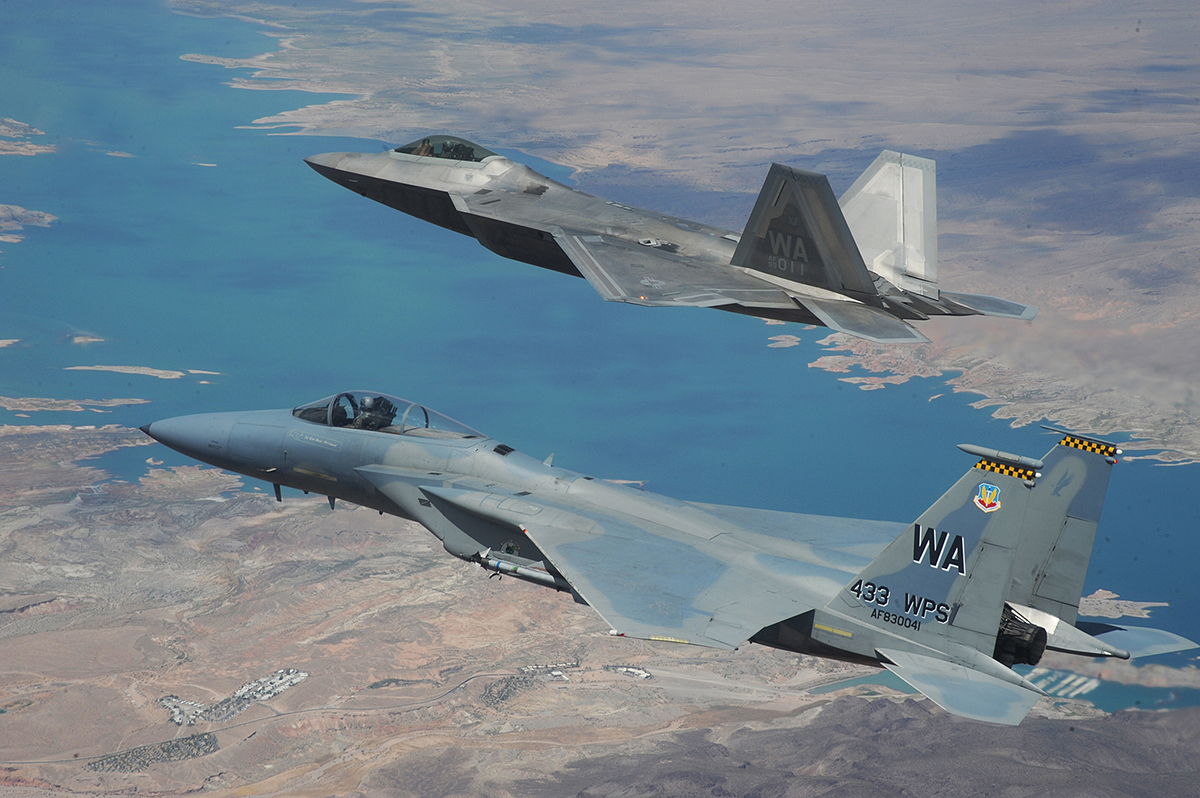
In other words, it takes the F-22’s high-fidelity sensor picture from beyond the front lines and simulcasts it to Eagles and potentially all other allied platforms in the battlespace to see and exploit.
The F-22 can receive Link 16 information but it cannot broadcast in that same form as it could give away their location. By using the Talon Hate as a translator, the F-15s and F-22s can share a common “tactical picture.” This opens up the possibility to employ a whole host of tactics that combined equal more than the sum of their parts.
Boeing has unveiled concepts that have as many as 16 BVR missiles loaded onto an F-15 at one time. This loadout turns the Eagle into a small arsenal ship more than anything else. The missile laden F-15s, operating behind F-22s and even F-35s, who themselves are operating at the forward edge of the battlespace, can provide a steady supply of missiles for the stealth fighters even after their magazines run dry. Think of them as flying artillery batteries.
Working as forward air controllers of sorts, stealthy fighters, and especially the F-22, can use their forward position and advanced sensors to request and direct missiles shots from F-15s operating many dozens of miles behind them. All the while the unstealthy F-15s remain outside the range of the same enemy aircraft they are sending missiles towards to kill. This is where the Meteor’s extreme range and dynamic flight profile could be extremely useful. It keeps the stealth fighters in the fight long after they have expended their own missile stocks and keeps the more vulnerable F-15s at a safe distance from threat aircraft.
The opposite tactic can also be used, albeit at a decrease sensor horizon. The F-15C’s can use their massively powerful radars to scan the skies for enemy aircraft, and deliver that sensor picture to the forward operating F-22s and F-35s. With that information the stealth fighters can operate in their most deadly mode, electromagnetically silent with no radar emissions at all. Loaded with Cuda type missiles and with a full picture of the battlespace ahead, they can maraud enemy formations in great numbers.
So yes, the Meteor’s range could benefit the F-15C and F-22, but not necessarily that much when you put both aircraft in a vacuum. But when you put them together and enlist the F-15C into arsenal ship operations, having the longest-range missile available with strong “end game” kinematics really enhances the capability of the F-15/F-22, and even the F-35, air dominance team.
What’s new today is old tomorrow
Although the Meteor is just entering service, there are new technologies around the corner that may see the missile age far faster than the AIM-120 has over the last 25 years. Then again, if MBDA can react swiftly enough to changing capabilities, the Meteor could be upgraded and reconfigured to stay at the forefront of air-to-air missile technology, albeit this proposition takes a steady stream of cash to realize.
Multi-mode seekers, which primarily include both Imaging Infrared and active radar on a single missile, could benefit the AIM-120D and the Meteor, and will likely be commonplace on future BVR missiles. Such a setup means that during the terminal phase of flight the targeted aircraft will have to try and break the lock of both radar and a high-end imaging infrared seekers, the latter of which is impervious to electromagnetic jamming. Israel already has this technology working on their Arrow and Stunner interceptors and is looking to migrate the concept to the air-to-air realm.

Even tri-mode seekers, where BVR air-to-air missiles incorporate a anti-radiation homing function for suppression of enemy air defenses would be an ideal capability for stealthy aircraft with tight weapons bays and limited stores. This is exactly what was in the works to replace the AMRAAM in the late 2000s. The program was dubbed the Next Generation Missile (NGM) and later the Dual Role Air Dominance Missile (DRADM) before being cancelled by the Obama Administration 2013.
Since then other risk-reduction exploratory programs have emerged, like the Triple Target Terminator (T3) program led by DARPA, although not much has been heard about it for the last couple of years and it seems to have concluded after a limited flight test program was executed.
It is quite likely that any next generation BVR missile will also have a robust secondary ground-attack capability using GPS, radar and even infrared homing. It is even possible that versions of Cuda-like missiles may be adapted to facilitate laser targeting capability for striking small targets with minimal collateral damage. It’s all about flexibility and an extrapolation of the hot concept of “distributed lethality,” being able to use one weapon for multiple types of engagements, thus putting the enemy at greater risk over a larger area and in more ways.

The bottom line is that the AIM-120D signals the end of the AMRAAM’s design life cycle. This does not mean the final AMRAAM is not an incredibly capable missile, but there is only so much that can be pulled from a 25 year old high-performance missile design. The US will move to begin developing a new medium to long-range air-to-air missile very soon. In fact it seems pretty clear that a good chunk of this development has already happened with exploratory research and development programs, some of which were likely semi-clandestine in nature.
Then again, the Pentagon could just invest in and procure the Meteor and concentrate funding on developing smaller intermediate range missiles like the Cuda that are more tailored to its burgeoning 5th generation fighter force. This way the Meteor program would get a huge influx of money and would realize much larger production numbers, thus dropping the unit cost. It would also allow for quicker upgrades to the current design to be made to suit the DoD’s needs.
Sounds like a pretty slick idea right? Well it won’t happen.
The problem is that doing so would have poor support from the defense lobby and no general will get another star on their collar or a big defense industry gig after retiring by importing a missile from Europe. There simply isn’t enough money in it for defense contractors and the US will have nothing to sell to customers overseas in the same class.
In fact, we have laws against that sort of thing and the Meteor would likely have to be built under license here in the US if the Pentagon wanted to buy it en masse. Even then there won’t be lucrative development dollars to be had. Instead the DoD will likely independently develop a similar missile at great cost and will end up with just an upgraded Meteor.
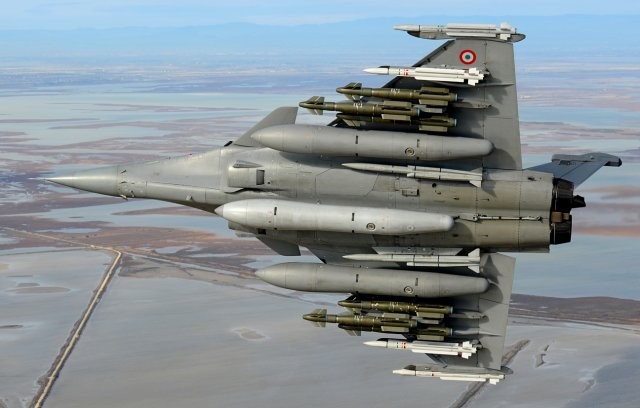
Is the Meteor a must-have masterpiece?
In the end the Meteor may have the longest range and largest no escape zone of any air-to-air missile in service today, but it is not necessarily the best solution for every fighter and every Air Force out there.
For 5th generation stealth fighters, who can operate far closer to threats than their 4th generation progenitors, quantity is more of an advantage than range alone for most combat situations. For 4th generation fighters with modern AESA radars and a quality networked fighting force backing them up, the Meteor can be very useful in limited situations and not really relevant in many others. But when you pair 5th generation fighters with 4th generation fighters and empower them with network connectivity, the equation changes and the Meteor can elevate both via a whole set of exciting new tactics. The AIM-120D can also do this, although to a lesser degree.
The thing is air combat is changing rapidly. With advanced unmanned combat air vehicles and automated swarm warfare that comes with them likely already a reality, as well as innovative ideas like the Cuda in development and airborne laser weapons on the horizon, both the AIM-120D and the Meteor are feel far less revolutionary than what seems to be right around the corner.
In the end calling the Meteor the best air-to-air missile in the world is a simplification of a very complicated proposition, although it certainly seems to have the best long-range engagement capabilities. The reality is that the title of best air-to-air missile in the world depends on what aircraft it is being deployed on and what aircraft it is being deployed against, as well as the combat scenario at hand.
For a Swedish JAS-39E Gripen NG, French Rafale or a Saudi Typhoon upgraded with an AESA radar the Meteor may be a dream weapon. If you are a country flying F-16s, Mirage 2000s or a similar 4th generation fighter without an AESA radar upgrade, limited networking capabilities, and especially if your country’s borders are not measured in the many hundreds or thousands of miles, the Meteor offers little benefit. Quite literally it can engage targets much farther than these jets’ radars can even see and for the air sovereignty/homeland defense mission its advantages are muffled.
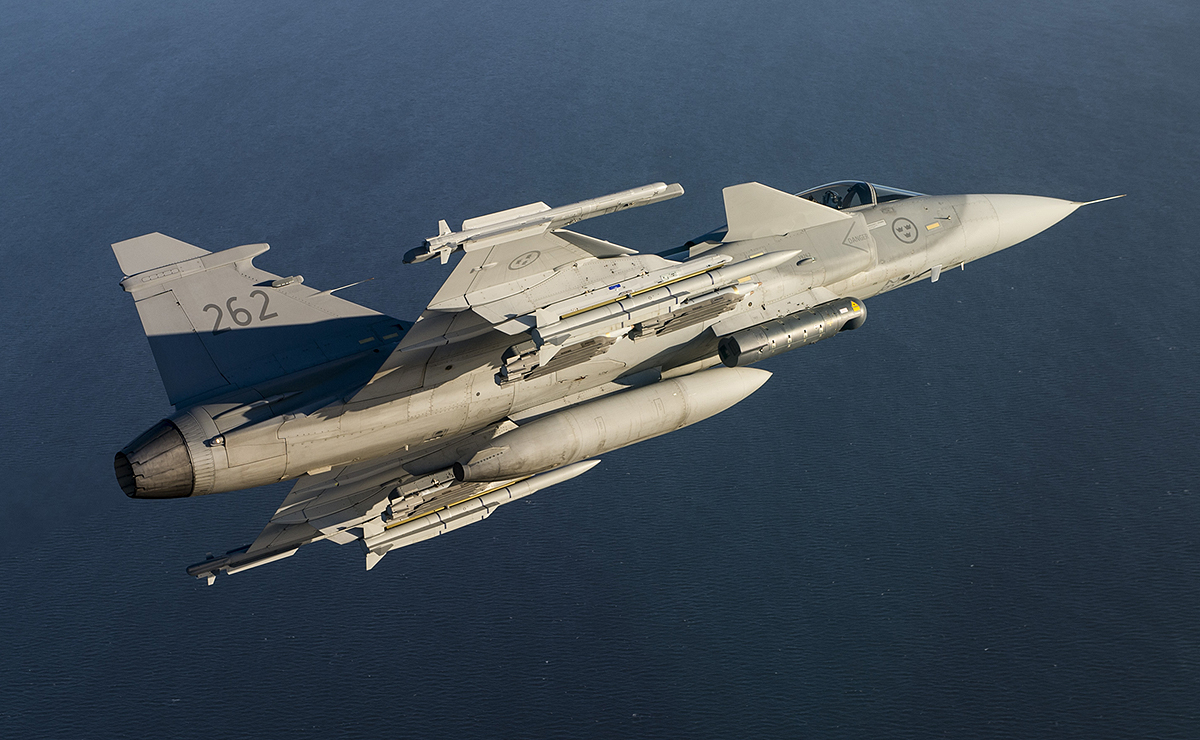
Finally, the reality is that the real performance data and the raw capabilities of these missiles are closely guarded secrets. You can find range estimates for the AIM-120D from about 40 miles to nearly 100 miles. Info on the Meteor is just as inconsistent, with range claims form from around 60 to 130 miles. How these missiles actually perform in various real-world scenarios is more important than their basic “brochure” fly-out ranges and features. The AMRAAM has been test fired nearly 4,000 times and used in combat with multiple kills, the Meteor has a long way to go to catch up to figures like that.
Still, it is clear that the Meteor is a seriously capable weapon and it represents a leap in some aspects of BVR missile technology. Does that warrant the title as the best air-to-air missile in the world? Well that is up to you to decide. But as we have discussed, other leaps in air-to-air combat tech are right around the corner and there are strong indications that in this post operational 5th generation fighter reality extreme-range is no longer the Holy Grail air-to-air missile technology.
Contact the author Tyler@thedrive.com
